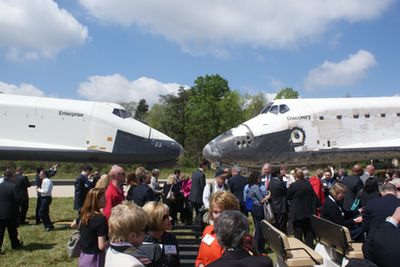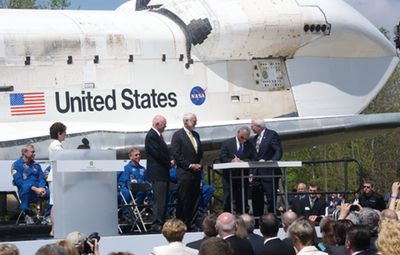
A shuttle’s transfer in an agency’s era of transitionby Jeff Foust
|
| At a distance, it might have looked like the reunion of long-lost twins, a pair of white winged vehicles with black underbodies and accents. On closer inspection, though, the differences between the two became clear. |
A month after the museum’s opening, the indefinite future got a little more definite with the unveiling of President George W. Bush’s Vision for Space Exploration, which called for retiring the shuttle fleet upon the completion of the International Space Station in 2010. That announcement effectively started a countdown—albeit one with its fair share of holds, as the final shuttle missions stretched into mid-2011—for last week’s events, as NASA ferried Discovery from the Kennedy Space Center in Florida to Dulles, and formally handed the orbiter over to the museum. While nothing about those events was particularly surprising, the event did reopen some old wounds about the shuttle’s retirement and America’s future in space.
 Enterprise (left) and Discovery sit almost nose to nose after Thursday’s ceremony. (credit: J. Foust) |
The transfer of Discovery to the National Air and Space Museum was a relatively straightforward process, but one full of ceremony and unique visuals. The 747 aircraft ferrying Discovery took off from the Kennedy Space Center around sunrise Tuesday and, making passes over the beaches of the Space Coast and the space center itself, headed north towards Washington.
Once in the Washington area, the plane made several passes of the airport and Udvar-Hazy Center (see “Pictures at an exhibition”, The Space Review, this issue) as well as flying over Washington itself. Tourists and locals alike flocked to the National Mall and building rooftops to catch a glimpse of the 747 and Discovery as it made several low passes over the city before heading back out to land at Dulles.
Forty-eight hours after Discovery arrived at Dulles, the Udvar-Hazy Center formally hosted a ceremony to accept the orbiter into its collection. On one side of the taxiway behind the museum was Enterprise, which has been towed out of the museum earlier in the morning. On the other was Discovery, which, as the ceremony started, was towed into view, escorted by a coterie of former astronauts who flew on the orbiter.
Placing the two orbiters nose to nose offered a study in contrasts. At a distance, it might have looked like the reunion of long-lost twins, a pair of white winged vehicles with black underbodies and accents. On closer inspection, though, the differences between the two became clear. The reaction control system thrusters on the nose of Enterprise were simply gray circles and ellipses; on Discovery, they were the real thing. Enterprise had the old gray “worm” NASA logo on the rear corner of its cargo bay door, while Discovery had the blue “meatball” logo that NASA re-adopted two decades ago on the side of its fuselage.
The biggest difference, though, was its general appearance. Enterprise was a bright shade of white, gleaming in the sunshine as early morning clouds burned off. Discovery, though, was duller, its tiles and thermal blankets discolored by the orbiter’s 39 trips into space. “I know we describe it as white, but you’ll notice it’s charred a little bit,” said NASA administrator Charles Bolden—himself a former commander of Discovery—in his remarks at the ceremony. “Try going through 3,000 degrees and see if you don’t get a little charred.” The contrast made Enterprise look something like a replica compared to the grizzled spaceflight veteran parked next to it. One aspired to fly; the other flew in space for a year.
The rest of the formal event featured speeches by Bolden, various Smithsonian officials, and even former astronaut and senator John Glenn, who returned to space on Discovery’s STS-95 mission in 1998. After the speeches, Bolden, National Air and Space Museum director Jack Dailey, and Wayne Clough, secretary of the Smithsonian Institution, formally signed the papers that transferred the orbiter from NASA to the Smithsonian.
| “There’s no need crying over what happened in the past, let’s get on with the future,” Glenn said of the decision to retire the shuttles. |
While the proceedings were relatively unremarkable (beyond the pair of shuttle orbiters that provided the event’s backdrop) there was a little emotion at the ceremony as well. After introducing the former Discovery commanders and other astronauts on the stage, Dailey said, “This one of the greatest gatherings of astronauts, probably, in the history of NASA,” he said, then paused. “This is harder than I thought.” A moment later, he seemed to struggle with his words while praising the space agency and its astronauts. “It’s just—you’re experiencing something that… you’re not going to see again.”
“I was reading the carefully prepared notes that I had, and then I started thinking about what was going on today,” Dailey explained to reporters after the event. “There was more talent up on that stage than probably gathered anywhere else in this country.”
 NASA administrator Charles Bolden signs the documents formally transferring Discovery to the Smithsonian as (from left) former Senator John Glenn, Secretary of the Smithsonian Wayne Clough, and National Air and Space Museum Director Jack Dailey look on. (credit: J. Foust) |
The arrival of Discovery in Washington also allowed others to reflect on the past and future of NASA during an era of transition for the space agency. For some, that meant lamenting what they considered to be a premature end for the shuttle program, while others wondered if NASA had any future at all.
Glenn, who has long been critical of the retirement of the shuttle, expressed his regrets in his speech. “The unfortunate decision made eight and a half years ago to terminate the shuttle fleet, in my view, prematurely grounded Discovery and delayed our research, but those decisions have been made, and we recover and move on with new programs,” he said.
In comments to reporters after the event, Glenn said he had reconciled himself to the decision to retire the shuttle now. “I would have preferred that the shuttle be continued until we had its replacement all tested and in place,” he said. “But that decision has been made and it’s behind us. There’s no need crying over what happened in the past, let’s get on with the future.”
This transfer does come at a sensitive time for NASA. The agency is trying to make the case that it has a bright future ahead with its suite of robotic and human spaceflight activities, while combating the perception that the retirement of the shuttle is tantamount to the end of human spaceflight, if not the space agency itself.
| “The shuttle was being carried—its pallbearer, a 747—because it cannot fly, nor will it ever again. It was being sent for interment… just as surely embalmed as Lenin in Red Square,” Krauthammer wrote. |
The Discovery ceremony did trigger some criticism in the media about the agency’s future. In an editorial, the Washington Times saw particular symbolism in the flight of the shuttle over Washington. “The flyby was a metaphor for the entire space effort, a brief moment of excitement when Americans looked to the skies. It soon faded on the horizon and was gone,” it stated. “The agency has become a pale parody of its former self.”
In an op-ed for The Hill, Congressman James Sensenbrenner (R-WI), the former chairman, and current vice-chairman, of the House Science Committee attached a somber mood to the shuttle’s arrival. “After the excitement of the day’s events died down, we are reminded that the Discovery flyover was more a funeral procession than a celebration,” he wrote. He complained that “poor planning” resulted in the shuttles being “relegated to museums”, but was optimistic about the future. “America’s role in space exploration is far from dead. In fact, it’s possible its best years are yet to come.”
No such optimism was present in a widely syndicated piece by Washington Post columnist Charles Krauthammer, who also likened Discovery’s arrival to a funeral ceremony, but in stronger language. “The shuttle was being carried—its pallbearer, a 747—because it cannot fly, nor will it ever again. It was being sent for interment… just as surely embalmed as Lenin in Red Square,” he wrote. He likened the shuttle’s retirement without a successor—he was skeptical of NASA’s plans to develop the Space Launch System and Multi-Purpose Crew Vehicle, as well as commercial crew systems—as a symbol of “willed American decline.”
Krauthammer’s criticism generated a rebuke from the administration in the form of a blog post on the White House web site by Bolden and Office of Science and Technology director John Holdren. “Nothing could be further from the truth” than what Krauthammer wrote, they argued. “The United States remains far and away the world leader in space technology and exploration.” They backed up that assertion by describing those activities, from research on the International Space Station to plans for human exploration beyond Earth orbit.
But do ceremonies like last week’s transfer of Discovery, and upcoming similar events in New York, Los Angeles, and the Kennedy Space Center, make it more difficult for NASA to get out the message that it’s not going out of business? Bolden, in response to a question on that after Thursday’s ceremony, disagreed. “In order to move on to another phase of life, you’ve got to get the other part done, and celebrate it, and move on,” he said. “This was the beginning of the new era: bringing Discovery here, and having people celebrate the incredible thirty-year history of the shuttle program.”
At the end of the day Thursday, Discovery was rolled into place in the hangar at the Udvar-Hazy Center, taking the spot that Enterprise had occupied less than twelve hours earlier. It will remain there effectively forever. “I don’t think we’ll ever move Discovery out unless the building itself is damaged or something,” said museum curator Valerie Neal. “If we do our job, Discovery will be here a thousand years from now, creating wonder,” said Clough.
| “If we do our job, Discovery will be here a thousand years from now, creating wonder,” said Clough. |
Both NASA and the museum hope that Discovery will be creating wonder now as well, providing a lesson about spaceflight’s past and inspiration for its future. “Today, we turn Discovery over to the Smithsonian, with great expectation that, as we have always done, NASA will continue to inspire the young people of today and tomorrow to dream of space,” Bolden said.
In an interview prior to the ceremony, NASA associate administrator for human exploration and operations William Gerstenmaier was asked what visitors to the museum a decade from now will think of the shuttle’s retirement when standing in front of Discovery. “Hopefully, they won’t even ask that question,” he responded. “If we do our job, they’ll know what we’re doing in space, they’ll know where we’re pushing those boundaries, and that question won’t even come to their minds.”
For one former astronaut, though, Thursday’s ceremony had a different significance. Talking to reporters after the ceremony, John Grunsfeld, a former astronaut who now is the agency’s associate administrator for science, fingered the collar of his blue flight jacket. “This morning on my flight suit, for the first time since the loss of Columbia, I took my STS-107 pin off,” he said. “I felt like this was an apt celebration. We flew out the program safely after Columbia. I’m looking forward to getting the next space vehicles going.”